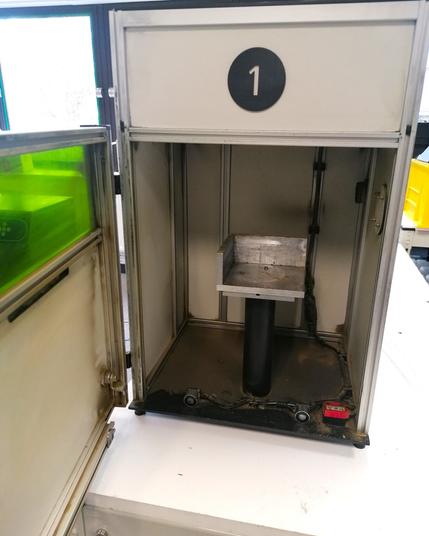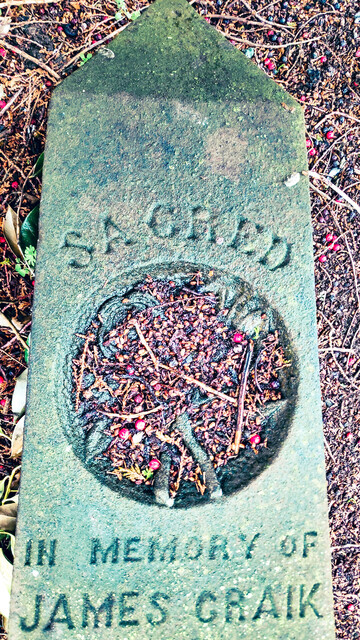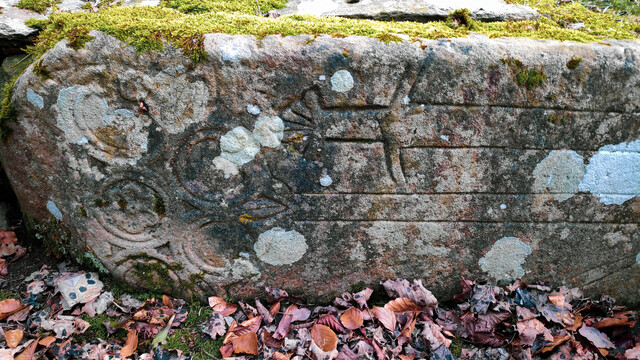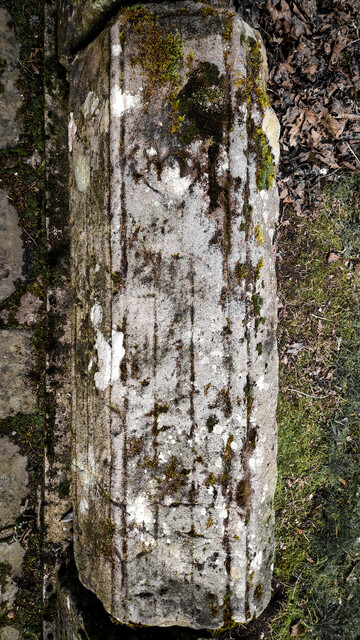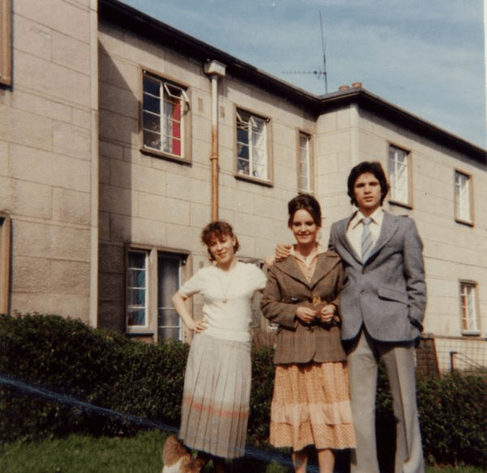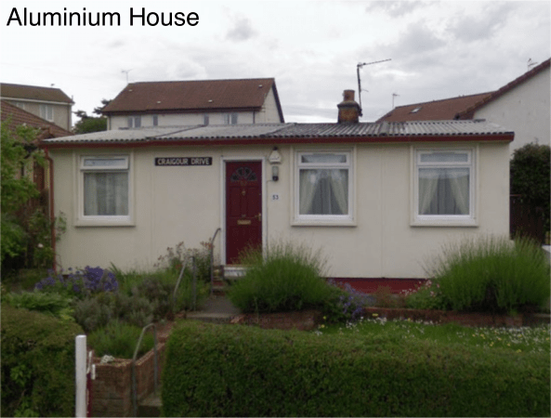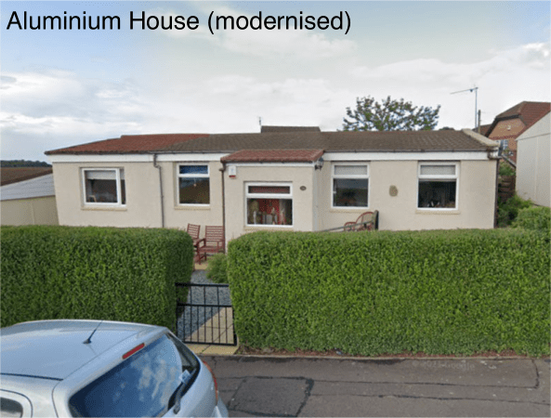An old laser made for Currie & Warner is in for repair with a scan head issue. The laser has mainly been used for marking brass fittings. We offer repair and service support for all our machines as well as other brands.
#Currie&Warner #LaserMarking #Repair #ThinkLaser
#Currie
@alisterb Hi from #edinburgh #currie
Lovely pictures 🙂
Sorry to be "that guy" but the insect in picture 1 is a hoverfly, a harmless (to humans) bee/wasp mimic.
In the months after Roe fell, their efforts would reach beyond the outlines of that one document.
A.D.F. lawyers would get involved in the two high-profile Supreme Court cases,
argued before the justices this spring,
that could define post-Roe abortion access for American women;
they focused on🔹 the legality of medication that is the most common method of abortion 🔹
and on 🔹emergency care for pregnant women who face grave medical complications🔹 in states where abortion is banned.
But all that was to come.
Onstage that night, Fitch beamed.
For so many decades, Roe had seemed indestructible,
the backdrop to the lives of three generations of American women
and their families.
Soon it would be a relic of an earlier time.
“We’ve got tough times ahead,
but we’re ready,” Fitch told the audience.
“This has been certainly a God thing.
We’ve all been called.
We’ve all been waiting.”
Now, she said, they would not stop.
“Everyone in this room, you’re ready.”
(15/15)
#Waggoner #Hawley #Barrett #Stewart #Fitch #Currie #Taylor #Fiedorek #Burke #Dannenfelser #AllianceDefendingFreedom #fedsoc #FederalistSociety #viability #Roberts #Kennedy #Alito #Leonard #Leo #Misha #Tseytlin
And now, amid the applause,
A.D.F. leaders looked ahead.
Their ultimate goal was sweeping change across America to preserve the values of conservative Christians.
A.D.F. was, after all, a “religious ministry,”
not just a legal network,
as Kristen Waggoner said in an interview.
Ending abortion was the first target, but A.D.F. had already begun planning for more.
According to an internal strategy document dated to May 2021,
A.D.F. leaders set out to achieve what they called
“generational wins,”
victories that,
like overturning Roe,
would change the law and the culture of America
for an entire generation.
The document, never before reported,
reveals secret details of the legal decisions A.D.F. hopes to challenge in the coming years.
A.D.F. lawyers would work to reverse the Supreme Court’s 1990 decision in
🔸Employment Division v. Smith, 🔸
to “fully protect the free exercise of religion,”
the strategy document explained.
That decision, written by Scalia,
ruled that religious beliefs did not excuse disobeying laws.
They would pursue litigation to enforce free-speech rights on college campuses.
They would push legislation to protect the freedom of association there as well,
to eventually overturn a decision that Ginsburg wrote in
🔸Christian Legal Society v. Martinez. 🔸
The ruling allowed a public university not to recognize a Christian student group that excluded gay students.
In his dissent, Alito called the decision a “serious setback for freedom of expression.”
They would target 🔹L.G.B.T.Q. rights and protections 🔹
and “stop efforts to elevate sexual orientation and gender identity to protected-class status in the law akin to race.”
They would “work to restore an understanding of marriage, the family and sexuality
that reflects God’s creative order.”
And they wanted the court to
🔹strengthen parental rights over state authority🔹
by having the court revisit the 2000 case 🔸Troxel v. Granville,🔸
which allowed the state to override a parent’s wishes in some circumstances.
A.D.F. would work to pass state legislation, similar to its approach on abortion,
that would prioritize parental rights in medical decisions for minors who say they are transgender,
to prevent parents from “being coerced into consenting to life-changing, ill-advised surgeries and procedures in the wake of gender dysphoria.”
It was an agenda that would inflame their liberal opponents and that not even everyone in the ballroom knew about.
(An A.D.F. official distanced the organization from the specific cases named in the document,
saying its legal strategies shift based on precedent and current events.)
(14/n)
#Waggoner #Hawley #Barrett #Stewart #Fitch #Currie #Taylor #Fiedorek #Burke #Dannenfelser #AllianceDefendingFreedom #fedsoc #FederalistSociety #viability #Roberts #Kennedy #Alito #Leonard #Leo #Misha #Tseytlin
After Stewart argued the case at the Supreme Court in December 2021,
leaders of the anti-abortion movement gathered that evening
at the JW Marriott in Washington
for an invitation-only dinner banquet
sponsored by A.D.F.
Everyone from the network seemed to be there,
and A.D.F. gave out party favors of small wooden plaques
depicting a pregnant woman leaning against a Supreme Court column.
The mood was celebratory even though their ultimate victory wouldn’t come for another six months,
with the decision in Dobbs v. Jackson that would overturn Roe.
Marjorie Dannenfelser was in the room.
As were local activists who pushed abortion bans through their statehouses.
Authors of the amicus briefs supporting Stewart’s case.
Becky Currie, who believed she had come up with the idea of the 15-week law in Mississippi.
Many participants knew only the small part they played,
not how the whole fit together.
Currie met Stewart briefly that night for the first time.
“He couldn’t pick me out of a crowd,” she said.
Onstage, Lynn Fitch, Scott Stewart and Erin Hawley sat proudly
as they described how they had gotten to this moment.
“First of all, to God be the glory,” Fitch began.
“We all prayed, worked so hard for this day.
It all came together because everyone here,
everyone that’s been involved across our country,
we’re believers,
and we knew this day would come,” she said.
“God selected this case. He was ready.
The justices were ready to hear what we were all going to be talking about.”
For those listening,
the people around them in that ballroom
and all they accomplished represented
a vision of the kingdom of God
coming on Earth,
as Jesus’ prayer taught in the Gospels.
Their work offered a vision of what a modern Christian empire looked like.
It did not involve violent crusaders or declaring an official state religion.
It was not clerics instituting a theocracy.
The anti-abortion movement had used the existing system to define the Constitution the way it saw fit.
A right was not being taken away from women,
the movement argued,
because it never should have existed in the first place.
Even Ruth Bader Ginsburg had said Roe,
rooted in a right to privacy,
wasn’t built on the strongest legal ground.
An argument explicitly based on a constitutional right to equal protection would have better protected it from challenges, she argued.
A.D.F.’s strategy on Dobbs reflected how it believed it could reshape America
and overtake majority opinion.
There’s a saying that law is downstream from culture,
said Greg Scott, a former longtime communications strategist for A.D.F.,
explaining the idea in an interview that a cause gains popular support first
and then the law formalizes those beliefs.
“I actually reject that,” he said.
“We are in this feedback loop and this ecosystem where frequently that is true.
But then at other times, the law does drive culture.”
(13/n)
#Waggoner #Hawley #Barrett #Stewart #Fitch #Currie #Taylor #Fiedorek #Burke #Dannenfelser #AllianceDefendingFreedom #fedsoc #FederalistSociety #viability #Roberts #Kennedy #Alito #Leonard #Leo #Misha #Tseytlin
Stewart’s thinking reflected the shifts that had overtaken the anti-abortion movement and the conservative legal project
during the Trump administration.
For four years, they had gone bigger and bolder than what previously felt possible.
Courts blocked many of their state abortion bans. But the efforts themselves had further opened the window of possibilities.
To overturn Roe, conservatives had to directly ask the court to do so.
A.D.F. might have been skittish about making the request, but Fitch and Stewart were not.
While the anti-abortion views of the movement’s leaders still represented a distinct minority of the country,
they had built an elite legal and ideological ecosystem of activists, organizations, lawmakers and pro bono lawyers around their cause.
Their policy arms churned out legal arguments and medical studies.
Their lawyers argued their cases, and their judges ruled on them,
all fostered by the bench that Leo built.
And their allied lawmakers pushed their agenda in statehouses and Congress.
Yet despite their overwhelming success, many on the left continued to underestimate them. It was their greatest strength.
Behind closed doors, Fitch’s team drew up a nine-slide blueprint, marked “Confidential”:
a 12-month political and public-relations strategy in the run-up to the expected court decision on Dobbs in June 2022.
“Strategy to maximize impact at SCOTUS,” it began.
The whole operation was surprisingly low-budget,
estimated as up to $231,000,
to be paid out of the attorney general’s office and Fitch’s political fund,
according to the private document.
When Stewart filed the new brief for Mississippi that July,
his argument was a full-scale assault on a precedent that had defined American life for nearly half a century,
in plain language.
“Roe and Casey are egregiously wrong,” he wrote.
“The conclusion that abortion is a constitutional right has no basis in text,
structure, history,
or tradition.”
That same month, Stewart attended a reunion of Thomas’s law clerks hosted at a West Virginia resort by the justice
— before whom he would soon argue his case.
If Stewart won, Roe would fall.
At least 13 states already had trigger bans on the books,
making them certain to move quickly to ban abortion,
with very limited exceptions.
And at least a dozen more states were likely to follow quickly with their own restrictions.
A victory by Mississippi could make abortion illegal in about half the country.
(12/n)
#Waggoner #Hawley #Barrett #Stewart #Fitch #Currie #Taylor #Fiedorek #Burke #Dannenfelser #AllianceDefendingFreedom #fedsoc #FederalistSociety #viability #Roberts #Kennedy #Alito #Leonard #Leo #Misha #Tseytlin
Squeezed around a long table,
A.D.F. lawyers lined up on one side
and the Mississippi team on the other.
This private meeting,
one kept secret from the press,
top politicians and even other allies in the anti-abortion coalition,
would signify a pivotal turning point in the strategy of their movement.
This account of the meeting is based on interviews with multiple participants and people familiar with the discussion.
The A.D.F. lawyers outlined their thinking.
Priority No. 1, they argued, was to get the Supreme Court to
remove the viability line established in Roe as the limit for when states could ban abortion.
Removing that limit
— about 24 weeks
— would open the door to all kinds of restrictions being upheld by lower courts.
It would be a huge victory for their cause.
It was a backdoor way of gutting Roe,
invalidating the central principle of the original decision,
without requiring the justices to take the thornier step of overturning 50 years of precedent.
Stewart disagreed.
The lawmakers of Mississippi had enacted a law,
and that law was fundamentally incompatible with Roe, he argued.
“The people of Mississippi are pro-life,” he told the room,
according to Erin Hawley.
“They enacted this law. It is my duty to defend it to the best of my ability, and the right thing to do is to ask the court to overrule Roe.”
The only effective strategy, Stewart said,
according to participants,
was to target the very heart of it all:
the right to abortion that the court had found via
💥a right to privacy 💥
that it decided was protected by the due-process clause of the 14th Amendment of the Constitution in 1973.
The best argument was that Roe was wrong, he decided.
Some of the A.D.F. lawyers bristled.
Stewart’s plan felt risky and aggressive.
If the court wanted to use this case to overturn Roe, it could,
the A.D.F. team argued.
But to ask for that explicitly could be pushing too far too fast,
even for this new court.
A defeat would be devastating,
potentially even going so far as to reaffirm abortion rights in some way
and create another precedent to fight.
There was a lot to consider.
It wasn’t totally clear that they had five votes to fully overturn Roe right now.
Certainly, it was the best court they had faced in a long time.
But the 6-3 conservative majority was still new,
and the country was still reeling from the contentious Supreme Court battles of the Trump era.
And looming over the conversation was the reality that
Stewart had never argued a case at the Supreme Court.
By this point, A.D.F. lawyers had argued and won 12 Supreme Court cases.
The A.D.F. lawyers’ message was clear:
The safest path to victory was their plan.
They should simply ask the court to uphold their 15-week law.
Fitch’s team was grateful for A.D.F.’s help.
But to them, this had the feel of a power grab
— a bunch of Washington lawyers coming down to Jackson to take over once there was a chance to make history.
This was Fitch’s case.
She had chosen Stewart, and Stewart was determined.
Mississippi would forge its own path.
“Like everything else, you get four attorneys in a room, you’re going to get 10 opinions,”
Kevin Theriot, an A.D.F. lawyer, said later in an interview,
adding that he was on the phone for part of the meeting.
“It’s not that our original strategy went out the window.
It was just that instead of making
‘You should overturn Roe’ the second argument,
they made it the first argument.”
(11/n)
#Waggoner #Hawley #Barrett #Stewart #Fitch #Currie #Taylor #Fiedorek #Burke #Dannenfelser #AllianceDefendingFreedom #fedsoc #FederalistSociety #viability #Roberts #Kennedy #Alito #Leonard #Leo #Misha #Tseytlin
It was not a moment for compromise, Stewart reasoned,
according to people familiar with his thinking.
It was a lesson he had learned from Thomas,
his former boss and mentor,
who was known to hold the line without deviation.
He would be steadfast:
Roe and Casey were wrong and must be reversed.
Within weeks, in early June 2021,
A.D.F. lawyers were on flights to Jackson.
It was a crucial moment for the entire anti-abortion coalition.
But even after years of pushing for this singular goal,
the coalition was not a monolith.
Stewart wanted to openly ask the Supreme Court to
overturn Roe.
A.D.F. also wanted Roe overturned, of course
— its ultimate target was to ban abortion nationwide at conception
— but it favored a more limited, less risky approach,
lawyers at the organization recalled in a series of interviews.
And they saw the Dobbs case as their project.
Now they just had to make sure Stewart and Fitch didn’t jeopardize the plan that had been laid almost six years earlier with Tseytlin at the Mayflower Hotel.
The A.D.F. lawyers rode the old mirrored elevators of the Walter Sillers State Office Building in Jackson to the 12th floor
for a private meeting with Fitch and Stewart.
This could be the case of a generation, and A.D.F. wasn’t about to cede control.
A.D.F.’s incoming president,
Kristen #Waggoner,
brought a core team of top-notch attorneys and media experts,
including a new lawyer A.D.F. had hired:
Erin #Hawley, a graduate of Yale Law School.
She was married to Senator Josh Hawley of Missouri.
Overturning Roe was a joint mission for the Hawleys, who met as clerks for Chief Justice Roberts.
(10/n)
#Barrett #Stewart #Fitch #Currie #Taylor #Fiedorek #Burke #Dannenfelser #AllianceDefendingFreedom #fedsoc #FederalistSociety #viability #Roberts #Kennedy #Alito #Leonard #Leo #Misha #Tseytlin
Over the past decade and a half, the job of state solicitor general had become a coveted slot for ambitious young lawyers,
even a path to more prominent posts like judgeships.
For Stewart, the opportunity was ideal
— representing a Republican state when there was a Democratic president offered the potential for high-profile conflict.
And there was the lure of Dobbs v. Jackson Women’s Health,
the Mississippi case named for its petitioner,
Thomas Dobbs
(whose name was on the case in his capacity as a state health officer),
which had been appealed up to the Supreme Court.
Dobbs could be Stewart’s first chance to argue a case before the justices.
Stewart had clerked for Judge Diarmuid O’Scannlain,
a pugnacious voice for right-wing judicial thought on the liberal Court of Appeals for the Ninth Circuit,
and for Clarence Thomas,
parlaying his conservative credentials into a post on Trump’s transition team,
assessing the legality of various potential policies.
When he got the job in Mississippi, a friend he had worked with at Gibson Dunn,
a law firm known in Washington as a conservative powerhouse,
reached out to congratulate him and share advice on becoming a new solicitor general.
It was Misha Tseytlin.
Now Fitch and Stewart watched the Supreme Court seem to ignore their case for months.
And like their opponents, they found the apparent indecision strange.
Everyone had a theory about why the justices were dragging their feet.
Maybe they would decide to not hear the case at all.
The silence broke one morning in May 2021.
Fitch was on her way to the airport after attending an event hosted by the Republican Attorneys General Association.
That weekend, the organization held an exclusive gathering at a private island on the secluded coast of southeast Georgia
nestled between the marsh and the sea.
There, corporate bigwigs schmoozed with top state law-enforcement leaders,
people like Fitch,
who would often determine the fate of their interests in America’s highest courts.
Now Fitch stared at the text from her chief of staff,
Michelle Williams,
trying to absorb the magnitude:
“We just got cert.”
The Supreme Court had agreed to hear the case that could strike at Roe.
The hopes of the conservative movement,
and the fears of those who supported abortion rights,
rested with Mississippi.
Stewart had to decide on a strategy.
Fitch’s petition for certiorari focused on upholding the Mississippi law
and mentioned the possibility of overturning Roe only in a footnote:
“If the Court determines that it cannot reconcile Roe and Casey with other precedents
or scientific advancements showing a compelling state interest in fetal life far earlier in pregnancy than those cases contemplate,
the Court should not retain erroneous precedent.”
Stewart knew that a lot of lawyers would encourage him to continue down that easier path,
to simply argue that Mississippi’s law should be upheld.
To not push for the complete overturn of Roe but to chip away
— as the movement had for so many decades
— and get the court to undo the viability standard.
But for Stewart, these circumstances were different from those in the past.
Trump had pushed their cause from the biggest bully pulpit in the land.
Conservatives now had a majority on the court that seemed to be on their side.
(9/n)
#Barrett #Stewart #Fitch #Currie #Taylor #Fiedorek #Burke #Dannenfelser #AllianceDefendingFreedom #fedsoc #FederalistSociety #viability #Roberts #Kennedy #Alito #Leonard #Leo #Misha #Tseytlin
Trump introduced Amy Coney #Barrett as his nominee in the Rose Garden, in the same place where Bill Clinton introduced Ginsburg in 1993.
Back then, Dannenfelser was 27 and dreaming of carving out a more powerful place for conservative anti-abortion women in Washington.
That was half a lifetime ago. Now, at 54, she and those women sat in the Rose Garden watching Barrett,
a Catholic mother of seven whom Trump had said he had been “saving” to succeed Ginsburg,
become the avatar of the culture they wanted to usher in for America.
Barrett was both Christian supermom and high-powered legal scholar,
elite and outsider,
a combination of the more secular conservative Federalist Society credentials
and the beliefs of the emerging Christian legal movement.
This new iteration of conservative feminism didn’t argue that women’s gains should be rolled back
or that women should not be professionally ambitious.
But it wanted those advances not to come at the expense of ideals of motherhood,
Christian morality
and the centrality of human life at conception.
Seven days before the 2020 presidential election,
Leonard Leo tuned in from his home in Maine to watch his close friend
Clarence Thomas swear in Barrett to the court.
Watching her raise her right hand felt like the culmination of the entire project.
It was, he said in an interview,
“exhilarating.”
Trump had become the most successful anti-abortion president America had ever known.
His administration transformed the judiciary.
With his speech to the March for Life in 2020
— the first time a sitting president attended
— and graphic comments in his 2019 State of the Union address about how abortion providers “execute a baby,”
he changed political expectations and red lines for Republican presidents.
What Trump and his Republican allies had done was to change the country
by leveraging political force to conquer the courts.
Trump had promised conservative Christians that
“Christianity will have power.”
And now that vision was at the center of a Republican Party they had remade.
Scott #Stewart had never set foot in Mississippi.
But Donald Trump’s defeat in the 2020 election thrust the young lawyer from the Department of Justice onto the job market,
and Lynn #Fitch, Mississippi’s attorney general, had reached out.
She needed a new solicitor general to lead the state’s biggest cases.
Fitch’s team found Stewart’s name tucked into a pile of résumés from the Republican Attorneys General Association,
a group that had received more than $13 million from Leo’s network of organizations
and whose executive director used to work for the Federalist Society.
(8/n)
#Currie #Taylor #Fiedorek #Burke #Dannenfelser #AllianceDefendingFreedom #fedsoc #FederalistSociety #viability #Roberts #Kennedy #Alito #Leonard #Leo #Misha #Tseytlin
But even as Currie proudly championed the bill, she would not know the full story behind it until after Roe fell more than five years later.
In an interview, she explained that she thought her vision for a 15-week cutoff,
rooted in her foundational story of the beating fetal heart,
had driven the plan.
No one had told her that A.D.F. had coordinated its strategy with Taylor before their meeting,
or that 15 weeks was part of its specific legal plan to undermine Roe, she said.
Or that Tseytlin had brainstormed this possibility at Leonard Leo’s Federalist Society cocktail hour
and advanced it at an upscale California resort alongside Republican leaders and attorneys.
When Gov. Phil Bryant of Mississippi signed the bill into law, with Currie smiling next to him,
it became the tightest restriction on abortion in the nation.
It made no exceptions for rape or incest, just a narrow provision to preserve the life of the woman or in cases of “severe” fetal abnormality.
Less than an hour later, Jackson Women’s Health Organization
— the Pink House
— filed a lawsuit through their attorneys at the Center for Reproductive Rights.
The Pink House performed abortions only until 16 weeks of pregnancy,
the center’s lawyers wrote,
and had done just 78 abortions when the fetus was identified as being 15 weeks or older in 2017.
Going after that small fraction, of course, was exactly the plan.
Not too early in pregnancy and not too late,
but exactly the line that might compel the Supreme Court to wade back into the subject of abortion.
“We were seeking to be incremental and strategic,” Taylor said.
Christian activists, he said, were learning to control their “moral passion” so as not to lose sight of their long-term goal.
There were still so many unknowns.
For the law to serve its intended purpose, anti-abortion activists needed a majority on the Supreme Court.
A.D.F. attorneys and their allies like Tseytlin had designed the legislation to target Kennedy,
but what they couldn’t foresee was that Kennedy would retire that summer,
allowing Trump to fill a second seat,
this time with Brett #Kavanaugh.
Now conservatives had a 5-4 split on the Supreme Court,
with Kavanaugh joining Roberts, Alito, Clarence Thomas and Neil Gorsuch.
And there was more to come.
“As a Christian,” Currie said, “sometimes you don’t know God’s plan, and he kind of makes things happen.”
In her Virginia office just across the Potomac River from Washington,
Marjorie Dannenfelser, of the Susan B. Anthony List
(now known as Susan B. Anthony Pro-Life America)
and the A.D.F. board,
had a detailed map drawn on a wall-size whiteboard.
From a distance, it looked like the kind used by political campaigns to track polling and turnout, swing districts and congressional votes.
But this one was color-coded to indicate states where Republicans held both the state legislature and the governor’s mansion
and was partitioned by circuit-court-of-appeals jurisdiction.
By early 2019, Republicans held complete control of state governments in 22 states,
giving them total power over abortion legislation.
Some 20 cases, with different legal strategies to gut Roe and Casey, were in litigation in lower courts.
A magenta triangle meant the state had passed a
“heartbeat bill,”
generally a ban that started around six weeks;
a green square signified a “pain-capable” abortion law,
typically a 20-week ban.
Red stars showed the federal appeals courts where judges nominated by Republicans outnumbered those nominated by Democrats
— of the 11 on the board, they controlled seven.
It was a map of how all the laws were moving up toward the ultimate court that mattered.
And now, on Sept. 18, 2020,
with the news of Justice Ruth Bader Ginsburg’s death,
Dannenfelser and her compatriots could capture another majority.
The kind of Supreme Court supermajority that could take down Roe.
(7/n)
#Currie #Taylor #Fiedorek #Burke #Dannenfelser #AllianceDefendingFreedom #fedsoc #FederalistSociety #viability #Roberts #Kennedy #Alito #Leonard #Leo #Misha #Tseytlin
Taylor knew a 15-week ban would criminalize only about 3 percent of the roughly 2,600 abortions that were performed in Mississippi that year.
But stopping procedures was not the point.
A.D.F.’s primary goal was to write bills as a litigation strategy,
not draft laws that would make for the strongest public policy
or end the greatest number of abortions.
The Mississippi bill was a legal tool to provoke a Supreme Court challenge to Roe
— and set in motion a much larger plan to eventually end all abortion in America.
Some lawmakers in Mississippi worried that they would be sued if the bill passed
and did not want to be saddled with the exorbitant cost such litigation could bring.
But A.D.F. had a plan for that too,
offering to have its lawyers defend the law at no cost to the state.
This free legal counsel was a selling point for Taylor when he lobbied the legislators to take up the bill.
And Taylor had an important ally in the statehouse whom he knew he could count on to push an anti-abortion bill:
Representative Becky #Currie, a nurse, an observant Christian and at the time a
three-term legislator who was one of the state’s most ardent advocates for the cause.
“I’ve been pro-life since I was 18 and pregnant,” she said in an interview.
“The more we worked on the bill, it just felt anointed.
You just know when it was right.”
She sponsored and introduced the bill A.D.F. wanted, called the
"Gestational Age Act," in early 2018.
Currie’s experience as a nurse shaped her political views.
She often told the story of an incident in the hospital as a young nurse when a pregnant woman came in and delivered far too early.
The details varied in her telling
— sometimes the premature infant was a girl, at others a boy,
sometimes it was 15 weeks, at others 14.
But what Currie remembered most was that she waited until the heart stopped
so she could put the remains in a plastic container to send to the lab.
What Currie felt she understood about what happened was that the fetus “wanted to live.”
“I just never got over that,” she remembered.
Currie was exactly the kind of woman anti-abortion activists in Washington had strategized to make the face of their movement.
A single mother, Currie had decided against having an abortion but still fulfilled her dream of becoming a nurse and then a politician.
She could speak personally and authentically about the subject and her faith.
Across the country, Republican women made up less than 10 percent of state legislators from 2008 to 2017,
but they were significantly overrepresented as sponsors of anti-abortion bills.
Of the more than 1,600 anti-abortion bills introduced during that period in state legislatures,
nearly half had a female Republican co-sponsor,
and a third had a female Republican as the primary sponsor.
It became more complicated for Democrats to paint abortion opponents as anti-woman when women were leading the charge.
(6/n)
#Taylor #Fiedorek #Burke #Dannenfelser #AllianceDefendingFreedom #fedsoc #FederalistSociety #viability #Roberts #Kennedy #Alito #Leonard #Leo #Misha #Tseytlin
From the bus, Currie getting like Barcelona.
Another trip to Currie Kirk.
Reused stonework featuring swords, crosses and other emblems at the medieval Currie Kirk.
This axle is gonna kill me. Here's two photos -- 1st one I took during gear setup with a setup race. 2nd one was tonight after my final-assembly races/bearings were installed. The race added maybe 0.001" of depth, but the ring gear has almost 0.005" of radial run-out. :( Tomorrow, I'll tear it down and do another setup with a 0.006" pinion depth shim and call it.
#jeep #gears #currie #rockjock2 #dana60
This thread is a bit of an A-to-Z of the different types of permanent, prefabricated, post-war housing built in Edinburgh between 1945-1950.
In the aftermath of WW2, hundreds of thousands of temporary, prefabricated houses were built across the UK, as part of a national crash-building programme to ease urban slum dwelling, replace war losses and provide housing for men returning from war until the construction of permanent housing could catch up with demand. In Edinburgh, some 4,000 temporary prefabs were built, of four types; AIROHs, ARCONs, Tarrans and Uni-SECOs. But prefab housing wasn’t just temporary, it was also for permanent construction. It was hoped that by mass-manufacturing standard designs of modern houses in factories, they could be rapidly built with limited skilled labour.
A is for Aluminium. Some of the first permanent prefab houses ordered for Edinburgh were of the Permanent Aluminium or Blackburn Mk.II design. These were based on the AIROH (Air Industry Research Organisation for Housing) single-storey, temporary, aluminium cottages – of which some 54,000 were built – but with thicker walls and insulation, designed to last 60 years instead of the AIROH‘s ten. These were developed by the British aircraft industry as a way to find use for its skills and manufacturing facilities in the postwar environment, and to make use of a glut of scrap aluminium from surplus aircraft. This material has its advantages; it is light, strong, does not rust or readily corrode and – initially – readily available from scrapped aircraft. It took 2 tonnes of aluminium to build an AIROH house frame. So a single large fighter aircraft like a Typhoon give you all the aluminium for a house. The Blackburn Aircraft Company of Dumbarton got on board.
Aluminium House (Craigour)They have been described as an “airplane in house form“; manufactured in sections on an aircraft production line, in sections that could be transported by road, and assembled quickly on site by unskilled labour. They came pre-fitted with standard kitchens and bathrooms, all of which just needed connected together on site on a simple brick or concrete plinth. The problem for aluminium houses of all types was that the price of the material soon rebounded and they became very expensive to produce, but they filled a gap and were not the worst of the temporary prefabs by any stretch.
Edinburgh purchased 166 permanent Blackburn Aluminium Houses; 145 for the Craigour Scheme in Moredun and 21 for Muirhouse.
Aluminium House in Craigour, with a porch and extra wing added, re-roofed, insulated and re-clad.These houses are quite easy to identify, as they are small, detached cottages with 3 regularly-sized windows and an offset front door. The shallow-pitched roof has a small brick chimney stack and was originally aluminium sheeting. There were 3 overlapping joints on the façade where the 4 prefabricated modules were joined together. These houses were quite popular, they sit on large plots and have big gardens. They are detached and the frames have not been subject to corrosion. Many have been insulated, re-clad, re-roofed and even extended. Some have been demolished and new houses built on their plots.
B is for BISF. These houses were named after their manufacturer and designer, the British Iron and Steel Federation. The house is of a conventional, semi-detached design, but uses a steel frame with steel window and door surrounds and Critall-Hope steel framed windows. The lower storey was clad in render applied to a steel lath and the upper storey had steel sheeting formed to look like timber. Interior partitions were plasterboard or wooden fibreboard and insulation was glass fibre. Most have been stripped back to their frames, re-insulated and re-clad with pebble-dash, and given modern plastic double glazing units. The fibreboard walls were prone to damp and fire and most were replaced with plasterboard during refurbishments.
In Edinburgh, c. 300 of these houses were built in Southhouse / Buirdiehouse (1947) and Moredun / Fernieside (1949) Schemes and most (if not all) remain to this day. They are somewhat unusual in that they were always intended to be permanent, and have not suffered from the usual structural degradation and corrosion that have plagued other non-standard houses. As such they are one of the few prefab designs that have never been designated as defective (which means you can get a mortgage on one).
B.I.S.F. houses. That on the right is unusual in that it retains its original cladding (Southhouse / Burdiehouse)A “naked” BISF house showing the slender framework next to the completed house. There is a concrete block firebreak between the two houses in the block.Useful identification features for BISF houses are that they are always semi-detached; they have a single, squat, central chimney on a pitched roof; the re-clad houses often have a mix of brick and pebble-dash cladding; the main ground floor window extends almost to floor level; and they lack the heavy reinforced concrete door and window surrounds of the concrete houses.
B is for Blackburn Orlit. These houses were a collaboration between the Blackburn Aircraft Company in Dumbarton and the Orlit Construction Company (see under O). They were designed in 1949 and used an improved, simplified version of the Orlit reinforced concrete frame and wall panel system, combined with the lightweight aluminium roof structure and pre-fabricated internal partitions covered in plasterboard, by Blackburn. Kitchens and bathrooms were also prefabricated “pods” produced by the Scottish Myton Company, based on experience with the Tarran temporary prefab houses. Four houses were built as a prototype in Clydebank in 1949, followed by 214 in 1950-51 on the Saughton Mains Scheme in Edinburgh, as semi-detached and terraces. Around 1,300 were built in total across Scotland.
Blackburn-Orlit (Saughton Mains South)These houses have the usual heavy, PRC door and window surrounds of Orlit houses and the irregularly-spaced concrete “quoins” on the corners. The ground floor front room window is deep (deeper than standard Orlits), but has often been in-filled with a shallower window. They have a shallow-pitched, gabled Blackburn roof (the roofs of Scotcon Orlits and those added to earlier Orlits are “hipped”) and lack the usual Orlit narrow, first-floor window over the front door. Instead they have 3 windows squeezed into the façade upstairs.
B is for Blackburn Mk.IV. Another collaboration between Blackburn and Orlit. These houses were of a more traditional construction, with walls constructed out of pre-cast “no fines” concrete blocks on a concrete slab foundation and Crittal steel-framed windows. I assume given Blackburn‘s involvement there were aluminium internal components used. You will find these in Edinburgh at the West Mains Scheme in Blackford,where 134 were built in 1951 as 4-in-a-block terraces. Nearly all have now been re-rendered, hiding their original concrete blockwork structure. Because they lack the Orlit‘s PRC frame and steel joints, they have not been classed as defective.
Blackburn Mark IV (West Mains)Identification features are the blockwork walls (where you can see them); the lack of the heavy, PRC door and window surrounds of most Orlit houses; the door surround has as small concession to detail (usually absent from such houses) with a moulding line around it; the central bay windows at ground floor level originally had a copper-sheathed roof.
B is for Blackburn Permanent. Also known as the Blackburn Mk.III, as the name suggests, this was a permanent house making use of Blackburn’s prefabricated internal partitioning and shallow-pitched aluminium roof structure, which was originally covered in aluminium sheeting. The form was basically the same as the Blackburn-Orlit house, but without the heavy PRC window and door frames and walls are traditional blockwork. Edinburgh built these as semi-detached and 4-in-a-block terraces, at Moredun in 1949 and the then Midlothian County Council as semi-detached houses in Currie in 1950.
Blackburn Permanent (Moredun)Blackburn Permanent (Currie)Identification features are the shallow roof pitch, squat chimneys, and the strip of 4 windows with brick infill on the first floor. Again there is a very deep sitting room window. These houses are usually harled or pebbledashed.
O is for Orlit. The Orlit System was developed by the Czech architect Erwin Katona, a Jewish refugee who had come to London in the late 1930s. He developed a modular, pre-cast reinforced concrete (PRC) system of construction that could be built in a factory and rapidly assembled on site with limited and unskilled labour. PRC columns and beams slotted together to form the structure, in-filled with an interlocking system of concrete tiles. Floors and roofs were of concrete channels. The roof could be a flat concrete slab covered in bitumen paper or a traditional wooden, pitched structure with tiles. Windows were Critall steel-framed, set within PRC concrete frames of standard sizes. The Orlit System could build a range of buildings, from single-storey cottages and municipal buildings to tenement flats. Usually they were semi-detached houses though.
An Orlit Type 1 House with its original windows and flat roof on Mountcastle Drive South, now demolished. CC-by-NC-SA via Thelma.The System was meant to be for permanent houses, with a 60 year lifespan, but was unfortunately riddled with flaws and weaknesses. Over time, PRC deteriorates, particularly at construction joints and junctions between components, with a gradual reduction in structural effectiveness. It suffers from inadequate thermal insulation, as well as thermal bridging – making houses cold and prone to condensation on the walls. As early as 1949, people in Edinburgh were writing to the newspapers to complain about the flaws in brand new Orlit houses. The original Type 1 system was replaced with the Type 2 to try and remedy the deficiencies. By 1950, they had abandoned the pre-cast frame system almost entirely (except for the window surrounds) and moved on to modular concrete block construction, which eliminated the structural weaknesses at least! All Orlit houses built to the original Type 1 or 2 systems have been designated defective.
Orlits were popular with Scottish local authorities and set up a subsidiary – the Scottish Orlit Company – with its headquarters and factory in Sighthill. Around 6,000 were built across Scotland, of which half have been subsequently demolished. Edinburgh built around 668, 410 of which have been demolished. These were a mix of the usual 2-storey semis and tenement flats; all of the latter were built at Bingham and were demolished in 1985. 134 semis were built at Saughton Mains (in 1948) and 80 at Southhouse / Burdiehouse (in 1947), all of which remain. This post does not cover the later 1950s-built Orlits at Ratho Craigpark, Oxgangs Farm and Gilmerton Dykes.
One of the last remaining Orlits in Scotland in its original state (excepting windows), at Fintry in Dundee in 2016The Orlit (Southhouse/ Burdiehouse)Orlit (Saughton Mains North)The Orlit System evolved over time, and has a large amount of variety available due to the flexibility of the system, however the best things to look for are the heavy outlines of the pre-cast concrete window surrounds, the narrow windows over the front door and to the side, and the bulky outline of the original concrete flat roof slab to which the later hipped roofs were added to remedy the deficient nature of the structure. I believe all Orlit System houses built in Edinburgh were originally flat roofed.
S is for Scotcon Orlit. Scotcon (from Scottish Construction Company) were a subsidiary of the Scottish Orlit Company, formed expressly to undertake local authority housebuilding in Scotland. While much of their work was prefabricated tower blocks, they also built on the standard Orlit system. 296 Scotcon Orlit houses were built in Edinburgh in 1950-51, a mixture of semi-detached houses and 3-storey tenements. 126 have since been demolished, but 170 remain; in the Niddrie Marischal Scheme (tenements and semis); at Saughton Mains (only 3 semis, perhaps built as demonstration models given their proximity to the Scottish Orlit Co. factory at Sighthill); Dunsmuir Court in Corstorphine (tenements) and at Easter Drylaw (tenements).
Because they use the Orlit system of PRC beams and columns, with pre-cast interlocking concrete block walls and PRC window and door surrounds, they are designated defective. They have traditional timber-framed, pitched roofs.
Scotcon Orlit (Niddrie Marischal)Scotcon Orlit (Saughton Mains)Scotcon Orlits look like other Orlits, with the heavy PRC window surrounds, but that of the ground floor front room is much deeper. They have the trademark narrow window over the front door, and (where they haven’t been covered up with pebbledash), irregular concrete “quoins”. The “hipped” roofs were built as pitched timber and tile structures, so they lack the heavy slab of the early Orlits built with flat roofs (to which a pitched structure was later added).
Scotcon Orlit Tenement (Drylaw Mains)Scotcon Orlit Tenement in the originally finished state, before later pebbledashingThe tenements can be recognised by the heavy PRC window surrounds, with the usual wide and deep front-room window, and narrow windows over the front door. All the Scotcon Orlit tenements in Edinburgh are 6-in-a-block. The ground floor houses have their own entrance doors to the side.
S is for Swedish Timber House. The Swedish government sold 5,000 flat-pack timber houses of a standard design to to the British Government after WW2. Half went to Scotland, particularly for rural housing, and the first 350 arrived as early as October 1945. Similar houses had been built in Glasgow in 1937 by the Swedish Government to demonstrate them to Scottish local authorities. 100 were gifted to Edinburgh Corporation by Sweden as a gesture of post-war good will, with 50 each erected in West Pilton and Sighthill under the supervision of Swedish foremen, as a mix of semi-detached and 4-in-a-block terraces. An additional handful were built by the SSHA at their Sighthill Demonstration Site.
Because they are of traditional timber construction with pitched, slate roofs, they have never been designated defective. Most have been externally insulated, and re-clad with harl or render, but some retain their original timber cladding.
Swedish Timber House (West Pilton)The Swedish Timber Houses at Sightill not long after they were built Cc-by-NC-SA Bill Lamb via ThelmaThe original tongue-and-groove timber cladding of thin strips, with those of the first floor overlapping the ground floor, are the best identification feature. They have a large front room window on the ground floor and a small canopy over the door. Most of those that still retain their timber cladding have been treated with dark brown or red preservatives, but originally they were brightly painted in cream. The roof is tiled and well pitched, with a single, central chimney to the front.
W is for Whitson-Fairhurst. These houses are named after their designers, W. A. Fairhurst and Melville, Dundas & Whitson Ltd. They were of a modular, prefabricated concrete system built by the Scottish Housing Group, a post-war conglomerate of housing builders who had pooled their resources to meet government and local authority contracts for mass construction. They use a system of PRC columns and beams to form the structure of the house, which are in-filled with an outer skin of brick and an inner skin of breeze blocks. Window surrounds and door frames are relatively heavy PRC structures. A traditional timber roof structure was covered in concrete roof tiles and they were harled or pebbledashed. 3,400 Whitson-Fairhurst houses were built in Scotland,. In Edinburgh they were only built in the Southhouse / Burdiehouse Scheme, where 100 semi-detached houses were built. They are designated defective.
Whitson-Fairhurst (Southhouse / Burdiehouse)At first glance they could be confused for an Orlit house, with heavy PRC window surrounds. The biggest difference is that the roof is of the gable-type (when seen from the front, the sides of the house are flat all the way to the top of the roof), not “hipped” as in Orlits (when seen from the front, the sides of the roof are pitched towards the top) The front window is much deeper and they lack the Orlit‘s signature narrow window above the front door.
If you have found this useful, informative or amusing, perhaps you would like to help contribute towards the running costs of this site (including keeping it ad-free and my book-buying budget) by supporting me on ko-fi. Or please do just share this post on social media or amongst friends.
These threads © 2017-2024, Andy Arthur
#Burdiehouse #CouncilHousing #Currie #Edinburgh #Houses #Moredun #Orlit #Pilton #PostWar #PRefab #publicHousing #Sighthill #Southhouse
